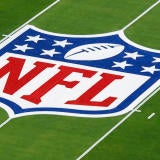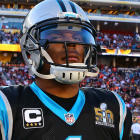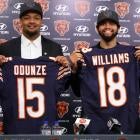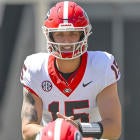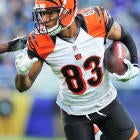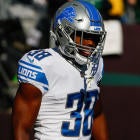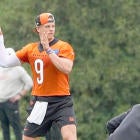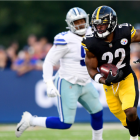Over the course of eight days, we will be unveiling our All-Division teams here at CBSSports.com. What does that entail? We're picking a quarterback, two running backs, three wide receivers, two tight ends, five offensive linemen, two defensive ends, two defensive tackles, four linebackers, three cornerbacks and two safeties from each division that we believe will have the best 2016 season. Over the last few weeks, we've narrowed down the final roster, and we'll present them in this space. We started with the NFC East and NFC West. We'll continue today with the NFC South.
Quarterback: Cam Newton, Panthers
Newton's sparkling 2015 season, in which he won the league's MVP award, was the culmination of a five-year-long progression that has led to him to the top of the NFL's quarterback heap. He may not be the consensus best quarterback in the league, but he's close.

While his completion percentage of 59.7 percent in 2015 was not great, it was affected by the fact that he threw the second-deepest average pass (10.9 yards) of any passer. His 7.1 touchdown percentage led the NFL and was the 10th-best mark for any quarterback since 2000 (minimum 250 pass attempts). Couple that with his career-low interception percentage (2.0 percent) and the most prolific rushing abilities (132 carries, 636 yards, 10 touchdowns) of any quarterback leaguewide, and it was clear that Newton was the NFL's best signal-caller last season.
The return of Kelvin Benjamin should help Newton's efficiency on throws down the field (Ted Ginn Jr. was one of the NFL's most drop-happy receivers in 2015) and in the red zone, where the 6-foot-5, 245-pounder caught three of his eight touchdowns as a rookie in 2014. The continued presence of Greg Olsen and more work for second-year man Devin Funchess gives Newton a batch of monster-sized targets to throw to. It helps that they're all big and physical enough to throw downfield blocks when Cam takes off.
The interior protection in front of Newton (and the push up the middle on his goal-line runs) is sound and should continue to be so, but it will be interesting to see if the Panthers' castoff tackle duo holds up in Year 2 after an unexpectedly strong season in 2015. If not, that could adversely affect his numbers, but we still expect him to be among the NFL's best players once again.
Running Backs: Devonta Freeman, Falcons; Doug Martin, Buccaneers
Freeman's huge 2015 season came pretty much out of nowhere. He wasn't even the clear starter at the beginning of the season; that was rookie Tevin Coleman. It took an injury to the former Indiana star for Freeman to take over primary ball-carrying duties.
He took that opportunity and (sorry for the pun) ran with it, to the tune of 130 carries for 666 yards and eight touchdowns, plus 33 catches for another 290 yards and a score over the ensuing six games. Freeman slowed down considerably over the rest of the season, but his 81.7 total yards per game still equates to a 1,307-yard season. With Alex Mack now keying the center of the Atlanta offensive line, more consistency should be in the offing for Freeman, who is clearly a foundational part of the Falcons offense.
Martin has been in the NFL for four seasons. He's played 16 games twice and 17 combined in the other two During the two healthy seasons, he's averaged 1,428 rushing yards (4.7 per carry), 8.5 rushing touchdowns, 41 catches, 371.5 receiving yards, and a receiving touchdown. During the two relatively unhealthy seasons, he combined for 950 rushing yards (3.6 per carry), three rushing touchdowns, 25 catches, 130 receiving yards, and no receiving scores.
What it comes down to is this: if Martin's healthy, he's really good; if he's not healthy, he's wildly below average. We're betting on health in 2016, and a possible step forward thanks to expected improvement from quarterback Jameis Winston.
Wide Receivers: Julio Jones, Falcons; Mike Evans, Buccaneers; Brandin Cooks, Saints
How do you improve on a 104-catch, 1,593-yard, six-touchdown season? If you're Julio Jones, by going off for 136 catches, 1,871 yards, and eight touchdowns the following year.

No NFL wideout saw a greater percentage of his team's targets (or a greater differential between his percentage and that of the next closest receiver on his team) in 2015 than Jones, now fully recovered from the broken foot he sustained two years ago and better than ever. How's this for consistency: Jones had three games all year where he didn't finish with at least six catches and 88 receiving yards. And he had at least nine catches and 92 yards in nine of 16 games.
With a better No. 2 receiver in town to demand at least some attention, Jones should at least be slightly more open in 2016. Not that it matters if he's open; he's going to catch the damn ball anyway.
Evans' catch rate and touchdown production both declined from 2014 to 2015, but a receiver that big and physical is unlikely to notch only three scores again. With improvement from Winston likely on the horizon and Vincent Jackson getting up there in age (he's 33 years old, 10 years Evans' senior), the young emerging star should become even more of the primary option than he was last season.
Considering Evans saw 148 targets in 15 games in 2015, that means he could be in for a huge year if his catch rate spikes even to around 60 percent, which would still be rather low for a No. 1 guy.
Cooks followed up a rookie season in which he had a sky-high catch rate (76.8 percent) but low yards per catch average (10.4) with one in which he was more efficient (13.5 yards per catch) and more explosive (nine touchdowns on 129 targets compared to three on 69 targets in 2014).
Being Drew Brees' No. 1 target is good for business, and Cooks established himself as very clearly that guy after fighting for the title with Willie Snead over the first half of the season. From Week 8 through the end of the season, Cooks hauled in 49 passes for 494 yards and eight scores, a full-year pace of 87-1,234-14. That stretch included six big games and three no-shows, though, so Cooks still needs to display that he can be the guy on a more consistent basis.
Tight Ends: Greg Olsen, Panthers; Coby Fleener, Saints
Third. Third. Fourth. Those are Greg Olsen's ranks among all tight ends in catches, receiving yards, and receiving touchdowns since arriving in Carolina in 2011. If you narrow it to just the last three seasons, those ranks are first, first, and fifth.

Rob Gronkowski is the NFL's best tight end and it's not that close, but Olsen has established himself as the next guy in line. He's still Newton's No. 1 target (his 124 targets led the team by 27 and the next closest guy after that had less than half the number of targets Olsen did) and one of the few tight ends that does his best work down the field. Watching Olsen work the seams between safeties and linebackers is a beautiful thing on a weekly basis.
Fleener never quite had the huge breakout campaign people were expecting from him in Indianapolis, but he still finished the last three seasons with at least 51 catches and averaged five touchdowns a year. Only 12 other tight ends have 15 scores in that time frame, while only seven others have caught 50-plus balls in all three years.
Fleener's now going from an Indianapolis offense where he split time with Dwayne Allen to being Drew Brees' No. 1 tight end. Considering Brees' top tight end has averaged 82-976-11 over the last three seasons, it's reasonable to expect a bump in Fleener's production. Granted, two of those three seasons came from Jimmy Graham, but if Ben Watson can put up 74-825-6 at age 35, Fleener should be able to produce some pretty big numbers in the middle of his physical prime.
Offensive Linemen: Terron Armstead, Saints; Jake Matthews, Falcons; Trai Turner, Panthers; Andrew Norwell, Panthers; Ryan Kalil, Panthers
If only the Saints could just keep finding quality starters in the third round like they did with Armstead, all their cap problems would go away. Still just 25 and heading into his fourth season, he has turned himself into one of the NFL's top tackles.
Per Pro Football Focus, Armstead allowed 20 pressures all year in 2015, and the Saints averaged 5.8 yards per carry running to his left. He's gotten better every year in pass protection and has maintained his excellent run-blocking since his rookie season. Protecting the blind side of Drew Brees is an easier job than some other left tackles have because of how quickly he gets rid of the ball, but Armstead still keeps his pocket clean enough to let Brees stand and fire down the field.
Matthews showed major improvement from his rookie season to his second year in the league. Per PFF, he allowed 16 combined sacks and hits in 2014, but that figured dropped to just seven in 2015. With an improving group around him (the guards got huge upgrades last season while fellow tackle Ryan Schraeder also showed a ton of improvement, and they're bringing in Alex Mack this year), he should rise to match the level of his linemates in 2016.
The interior group in Carolina forms the strength of the unit that allows Cam to do what Cam does. Turner, Norwell, and Kalil are all above-average run-blockers and pass-blockers. The two guards are just 23 (Turner) and 24 (Norwell) and should be getting better every season, especially while playing next to Kalil over the next few seasons. If the chemistry and ability they showed in 2015 shows up again in 2016, they'll be one of the NFL's best interior trios once again.
Defensive Ends: Cameron Jordan, Saints; Kony Ealy, Panthers
Jordan came off his huge extension (five years, $60 million) and had yet another huge season in 2015, notching 10 sacks and ranking among the league's top defenders in pressure rate. His 38 sacks over the last four seasons rank ninth in the league, and he's one of just four players (along with J.J. Watt, Justin Houston, and Ryan Kerrigan) with at least 7.5 quarterback takedowns in each of those four years.

Considering Jordan started off as a strong run defender who didn't get after the passer all that well, his improvement these last few years is the mark of a truly complete player.
Ealy has only nine sacks combined in his two NFL seasons, but he notched those figures as a part-time player. He was on the field for 35.1 percent of snaps in 2014 and 58.9 percent in 2015. That number should rise again in 2016, when he'll likely be a full-time starter.
The biggest argument in Ealy's favor? He likely would have been the MVP of Super Bowl 50 had the Panthers won after recording three sacks and an interception. Big things seem to be in store for the former second-round pick.
Defensive Tackles: Kawann Short, Panthers; Gerald McCoy, Buccaneers
Short played part-time in 2013, notching 1.5 sacks. He saw his playing time increase in 2014 and brought his sack total to 3.5. Then he was a full-blown started in 2015, and became one of the NFL's best defensive tackles with an 11-sack season.
Despite being selected after the Panthers took fellow defensive tackle Star Lotulelei in the 2013 draft, Short has become the more impactful player. He notched a sack, hit, or hurry on 11.2 percent of his pass rushes in 2015, the third-best mark among defensive tackles. He's no slouch in the run game, either.
McCoy, meanwhile, just keeps humming along as one of the best players in the NFL at his position. His monster deal may be a cap issue, but that doesn't disqualify him from being an excellent player.
McCoy's 26.5 sacks the last three seasons lead all defensive tackles, and he's joined by only J.J. Watt and Ryan Kerrigan with at least 8.5 in each of the last three years. He should continue to push the pocket and knock guards and centers on their asses in the run game from the middle of Tampa Bay's defense for at least the next few years.
Linebackers: Thomas Davis, Panthers; Luke Kuechly, Panthers; Lavonte David, Buccaneers; Kwon Alexander, Buccaneers
Davis and Kuechly are the best linebacker duo in the league. There are very few linebackers in the history of the league as good as Davis in coverage, and Kuechly is by simply the NFL's best overall linebacker.
David struggled to start 2015, but finished the season incredibly strong. Considering his first few years in the league, we're betting the second-half performance is more indicative of his skill level. He has at least 139 combined tackles in each of his four seasons, and while tackles aren't the best measure of a linebacker's skill level and/or performance, well ... somebody needs to knock down the ball-carrier.

Alexander had a missed-tackle issue as a rookie in 2015 (he had 27 of them) as well as a problem with over-pursuit on play-action plays, but if he cleans those up he'll make even more flash plays than he did during his first season. Someone who consistently makes flash plays is more than just a flashy player -- he's a stud.
Cornerbacks: Desmond Trufant, Falcons; Bene Benwikere, Panthers; Delvin Breaux, Saints
When Dan Quinn took over the Atlanta Falcons, everyone assumed he'd go looking for his version of Richard Sherman to start recreating the Seahawks defense down south. Turns out, his Sherman was already on the roster in the form of Trufant.
The fourth-year corner doesn't have Sherman's size (he's 6-foot to Sherman's 6-3) or ball skills (six picks in three years, compared to 5.2 per season for Sherman), but he has shown similar shutdown ability. Quarterbacks have completed less than 60 percent of passes thrown Trufant's way in all three of his NFL seasons. No corner was targeted less often in 2015, and that was as much a mark of Trufant's skill level as it was of the tendency for his defensive backfield mates to get burned.
It says something about the lack of both strength and depth of the NFC South corner crop that we had to throw both Benwikere (who was exposed a bit last season when he had to play outside as opposed to just in the slot) and Breaux (who had some great games and some terrible ones) onto the All-Division team. But with Josh Norman leaving for the greener (literally) pastures of the NFC East, they were the best options left available.
Safeties: Kurt Coleman, Panthers; Kenny Vaccaro, Saints
If we were making these teams before the 2014 season, it would have been hard to justify putting anybody but Saints safeties Jairus Byrd and Kenny Vaccaro in these two spots. But the last two seasons actually happened, and now it's pretty difficult to justify putting either of them on the list. Still, Vaccaro squeezed himself on with a "that's more like it" 2015 campaign. Byrd has just been too injured and ineffective for the majority of his two seasons in New Orleans to garner a spot.
Coleman's nine picks (seven regular season, two postseason) in 18 games in 2015 were probably an aberration, but he looked like an above-average starter overall during his first year with the Panthers. He'll be counted on to do even more in his second season now that Josh Norman is gone, and we think he'll prove up to the task in a scheme that fits his skill set well.











